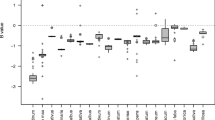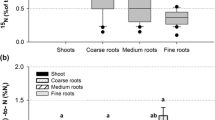Abstract
The effects of faba bean, lupin, pea and oat crops, with and without an undersown grass-clover mixture as a nitrogen (N) catch crop, on subsequent spring wheat followed by winter triticale crops were determined by aboveground dry matter (DM) harvests, nitrate (NO3) leaching measurements and soil N balances. A 2½-year lysimeter experiment was carried out on a temperate sandy loam soil. Crops were not fertilized in the experimental period and the natural 15N abundance technique was used to determine grain legume N2 fixation. Faba bean total aboveground DM production was significantly higher (1,300 g m−2) compared to lupin (950 g m−2), pea (850 g m−2) and oat (1,100 g m−2) independent of the catch crop strategy. Faba bean derived more than 90% of its N from N2 fixation, which was unusually high as compared to lupin (70–75%) and pea (50–60%). No effect of preceding crop was observed on the subsequent spring wheat or winter triticale DM production. Nitrate leaching following grain legumes was significantly reduced with catch crops compared to without catch crops during autumn and winter before sowing subsequent spring wheat. Soil N balances were calculated from monitored N leaching from the lysimeters, and measured N-accumulation from the leguminous species, as N-fixation minus N removed in grains including total N accumulation belowground according to Mayer et al. (2003a). Negative soil N balances for pea, lupin and oat indicated soil N depletion, but a positive faba bean soil N balance (11 g N m−2) after harvest indicated that more soil mineral N may have been available for subsequent cereals. However, the plant available N may have been taken up by the grass dominated grass-clover catch crop which together with microbial N immobilization and N losses could leave limited amounts of available N for uptake by the subsequent two cereal crops.




Similar content being viewed by others
References
Andersen A, Olsen CC (1993) Rye grass as a catch crop in spring barley. Acta Agric Scand B Soil Plant Sci 43:218–230
Armstrong EL, Heenan DP, Pate JS, Unkovich MJ (1997) Nitrogen benefits of lupins, field pea, and chickpea to wheat production in south-eastern Australia. Aust J Agric Res 48:39–47. doi:10.1071/A96054
Atkinson D, Black KE, Dawson LA, Dunsiger Z, Watson CA, Wilson SA (2005) Prospects, advantages and limitations of future crop production systems dependent upon the management of soil processes. Ann Appl Biol 146:203–215. doi:10.1111/j.1744-7348.2005.040061.x
Breland TA (1996) Green manuring with clover and ryegrass catch crops undersown in small grains: effects on soil mineral nitrogen in field and laboratory experiments. Acta Agric Scand B Soil Plant Sci 46:178–185
Crews TE, Peoples MB (2004) Legume versus fertilizer sources of nitrogen: ecological tradeoffs and human needs. Agric Ecosyst Environ 102:279–297. doi:10.1016/j.agee.2003.09.018
De Neergaard A, Hauggaard-Nielsen H, Jensen LS, Magid J (2002) Decomposition of white clover (Trifolium repens) and ryegrass (Lolium perenne) components: C and N dynamics simulated with the DAISY soil organic matter submodel. Eur J Agron 16:43–55. doi:10.1016/S1161-0301(01)00118-6
Evans J, McNeill AM, Unkovich MJ, Fettell NA, Heenan DP (2001) Net nitrogen balances for cool-season grain legume crops and contributions to wheat nitrogen uptake: a review. Aust J Exp Agric 41:347–359. doi:10.1071/EA00036
Fageria NK, Baligar VC, Bailey BA (2005) Role of cover crops in improving soil and row crop productivity. Commun Soil Sci Plann 36:2733–2757. doi:10.1080/00103620500303939
Francis GS, Haynes RJ, Williams PH (1994) Nitrogen mineralization, nitrate leaching and crop growth after plowing-in leguminous and non-leguminous grain crop residues. J Agric Sci 123:81–87
Ghaley BB, Hauggaard-Nielsen H, Hogh-Jensen H, Jensen ES (2005) Intercropping of wheat and pea as influenced by nitrogen fertilization. Nutr Cycl Agroecosyst 73:201–212. doi:10.1007/s10705-005-2475-9
Hansen EM, Eriksen J, Vinther FP (2007) Catch crop strategy and nitrate leaching following grazed grass-clover. Soil Use Manage 23:348–358. doi:10.1111/j.1475-2743.2007.00106.x
Hauggaard-Nielsen H, Jensen ES (2001) Evaluating pea and barley cultivars for complementarity in intercropping at different levels of soil N availability. Field Crops Res 72:185–196. doi:10.1016/S0378-4290(01)00176-9
Hauggaard-Nielsen H, De Neergaard A, Jensen LS, Hogh-Jensen H, Magid J (1998) A field study of nitrogen dynamics and spring barley growth as affected by the quality of incorporated residues from white clover and ryegrass. Plant Soil 203:91–101. doi:10.1023/A:1004350215467
Hauggaard-Nielsen H, Ambus P, Jensen ES (2003) The comparison of nitrogen use and leaching in sole cropped versus intercropped pea and barley. Nutr Cycl Agroecosyst 65:289–300. doi:10.1023/A:1022612528161
Helander CA (2004) Residual nitrogen effects on a succeeding oat (Avena sativa L.) crop of clover species and ryegrass (Lolium perenne L.) undersown in winter wheat (Triticum aestivum L.). Acta Agric Scand B Soil Plant Sci 54:67–75
Jensen ES (1986) The influence of rate and time of nitrate supply on nitrogen fixation and yield in pea (Pisum sativum L.). Fert Res 10:193–202. doi:10.1007/BF01049349
Jensen ES (1991) Nitrogen accumulation and residual effects of nitrogen catch crops. Acta Agric Scand 41:333–344
Jensen ES (1994a) Availability of nitrogen in 15N-labelled mature pea residues to subsequent crops in the field. Soil Biol Biochem 26:465–472. doi:10.1016/0038-0717(94)90178-3
Jensen ES (1994b) Leaching in small lysimeters of nitrate derived from nitrogen-15-labeled field pea residues. J Environ Qual 23:1045–1050
Jensen ES (1996a) Compared cycling in a soil-plant system of pea and barley residue nitrogen. Plant Soil 182:13–23. doi:10.1007/BF00010991
Jensen ES (1996b) Grain yield, symbiotic N-2 fixation and interspecific competition for inorganic N in pea–barley intercrops. Plant Soil 182:25–38. doi:10.1007/BF00010992
Jensen ES (1996c) Nitrogen acquisition by pea and barley and the effect of their crop residues on available nitrogen for subsequent crops. Biol Fertil Soils 23:459–464. doi:10.1007/BF00335923
Jensen ES, Hauggaard-Nielsen H (2003) How can increased use of biological N2 fixation in agriculture benefit the environment? Plant Soil 252:177–186. doi:10.1023/A:1024189029226
Karlsson-Strese EM, Rydberg I, Becker HC, Umaerus M (1998) Strategy for catch crop development II. Screening of species undersown in spring barley (Hordeum vulgare L.) with respect to catch crop growth and grain yield. Acta Agric Scand B Soil Plant Sci 48:26–33
Knudsen MT, Hauggaard-Nielsen H, Jornsgard B, Jensen ES (2004) Comparison of interspecific competition and N use in pea-barley, faba bean-barley and lupin-barley intercrops grown at two temperate locations. J Agric Sci 142:617–627. doi:10.1017/S0021859604004745
Kuo S, Sainju UM (1998) Nitrogen mineralization and availability of mixed leguminous and non-leguminous cover crop residues in soil. Biol Fertil Soils 26:346–353. doi:10.1007/s003740050387
Liebman M, Dyck E (1993) Crop-rotation and intercropping strategies for weed management. Ecol Appl 3:92–122. doi:10.2307/1941795
Maidl FX, Haunz FX, Panse A, Fischbeck G (1996) Transfer of grain legume nitrogen within a crop rotation containing winter wheat and winter barley. J Agron Crop Sci 176:47–57. doi:10.1111/j.1439-037X.1996.tb00445.x
Mayer J, Buegger F, Jensen ES, Schloter M, Hess J (2003a) Estimating N rhizodeposition of grain legumes using a N-15 in situ stem labelling method. Soil Biol Biochem 35:21–28. doi:10.1016/S0038-0717(02)00212-2
Mayer J, Buegger F, Jensen ES, Schloter M, Hess J (2003b) Residual nitrogen contribution from grain legumes to succeeding wheat and rape and related microbial process. Plant Soil 255:541–554. doi:10.1023/A:1026081015076
Mortensen L, Engvild KC (1995) Effects of ozone on 14C translocation velocity and growth of spring wheat (Triticum aestivum L.) exposed in open-top chambers. Environ Pollut 87:135–140. doi:10.1016/0269-7491(94)P2599-5
Peoples MB, Craswell ET (1992) Biological nitrogen fixation: investments, expectations and actual contributions to agriculture. Plant Soil 141:13–39. doi:10.1007/BF00011308
Peoples MB, Herridge DF, Ladha JK (1995) Biological nitrogen fixation: an efficient source of nitrogen for sustainable agricultural production? Plant Soil 174:3–28. doi:10.1007/BF00032239
Peoples MB, Gault RR, Scammell GJ, Dear BS, Virgona J, Sandral GA, Paul J, Wolfe EC, Angus JF (1998) Effect of pasture management on the contributions of fixed N to the N economy of ley-farming systems. Aust J Agric Res 49:459–474. doi:10.1071/A97014
SAS (1990) SAS procedure guide, Version 6, 3rd edn. SAS Institute, Cary, p 705
Shearer G, Kohl DH (1986) N-2-fixation in field settings—estimations based on natural N-15 abundance. Aust J Plant Physiol 13:699–756
Stevenson FC, Van Kessel C (1996) A landscape-scale assessment of the nitrogen and non-nitrogen rotation benefits of pea. Soil Sci Soc Am J 60:1797–1805
Thomsen IK (2005) Nitrate leaching under spring barley is influenced by the presence of a ryegrass catch crop: results from a lysimeter experiment. Agric Ecosyst Environ 111:21–29. doi:10.1016/j.agee.2005.05.001
Thomsen IK, Christensen BT (1998) Cropping system and residue management effects on nitrate leaching and crop yields. Agric Ecosyst Environ 68:73–84. doi:10.1016/S0167-8809(97)00134-5
Thomsen IK, Jensen ES (1994) Recovery of nitrogen by spring barley following incorporation of N-15-labeled straw and catch crop material. Agric Ecosyst Environ 49:115–122. doi:10.1016/0167-8809(94)90001-9
Thomsen IK, Kjellerup V, Christensen BT (2001) Leaching and plant offtake of N in field pea/cereal cropping sequences with incorporation of N-15-labelled pea harvest residues. Soil Use Manage 17:209–216. doi:10.1079/SUM200179
Unkovich MJ, Pate JS, Sanford P, Armstrong EL (1994) Potential precision of the delta 15N natural-abundance method in field estimates of nitrogen-fixation by crop and pasture legumes in South-west Australia. Aust J Agric Res 45:119–132. doi:10.1071/AR9940119
Unkovich MJ, Pate JS, Sanford P (1997) Nitrogen fixation by annual legumes in Australian mediterranean agriculture. Aust J Agric Res 48:267–293. doi:10.1071/A96099
Van Kessel C, Hartley C (2000) Agricultural management of grain legumes: has it led to an increase in nitrogen fixation? Field Crops Res 65:165–181. doi:10.1016/S0378-4290(99)00085-4
Vitousek PM, Aber JD, Howarth RW, Likens GE, Matson PA, Schindler DW, Schlesinger WH, Tilman DG (1997) Human alteration of the global nitrogen cycle: sources and consequences. Ecol Appl 7:737–750
Acknowledgments
The European Commission Contract No. FOOD-CT-2004-506223 New Strategies to Improve Grain Legumes for Food and Feed (GLIP) funded this study.
Author information
Authors and Affiliations
Corresponding author
Rights and permissions
About this article
Cite this article
Hauggaard-Nielsen, H., Mundus, S. & Jensen, E.S. Nitrogen dynamics following grain legumes and subsequent catch crops and the effects on succeeding cereal crops. Nutr Cycl Agroecosyst 84, 281–291 (2009). https://doi.org/10.1007/s10705-008-9242-7
Received:
Accepted:
Published:
Issue Date:
DOI: https://doi.org/10.1007/s10705-008-9242-7




